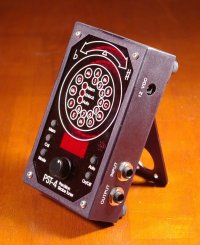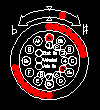[PST Home]
Precision Strobe Tuners
PST-4 Information
An Electronic Musical Instrument
Strobe Tuner for Musicians and Technicians

 The Precision Strobe Tuner is a musical instrument tuning aid
for technicians and musicians. It combines the principle of the mechanical
strobe tuner with solid state electronics, providing a tuning aid which
is highly accurate, compact, and easy to use. The difference in pitch between
the selected note and the input tone is displayed as the rotation of a two
group "pinwheel" pattern of lit LEDs opposite each other around the Strobe
Display. Users of mechanical type strobe tuners will find this very familiar.
The display is generated by linearly modulating the LED intensity with
the rectified input signal waveform, while electronically rotating the circular
array. This method used with a high density LED array provides display
texture not obtainable using techniques which enable the LEDs digitally
to generate a strobe effect. The PST-4 is a true strobe tuner.
The Precision Strobe Tuner is a musical instrument tuning aid
for technicians and musicians. It combines the principle of the mechanical
strobe tuner with solid state electronics, providing a tuning aid which
is highly accurate, compact, and easy to use. The difference in pitch between
the selected note and the input tone is displayed as the rotation of a two
group "pinwheel" pattern of lit LEDs opposite each other around the Strobe
Display. Users of mechanical type strobe tuners will find this very familiar.
The display is generated by linearly modulating the LED intensity with
the rectified input signal waveform, while electronically rotating the circular
array. This method used with a high density LED array provides display
texture not obtainable using techniques which enable the LEDs digitally
to generate a strobe effect. The PST-4 is a true strobe tuner.
It works like this: When a tone is applied to the device, a two group
"pinwheel" pattern is produced, with the direction of rotation indicating
whether the input tone is sharp or flat, and the rotation speed indicating
the degree. The Strobe Display response to pitch changes is instantaneous.
When the rotation is stopped and the groups stand still, the instrument is
perfectly adjusted. The tuner setting and operation modes are easily configured
through the user interface. The Strobe Display provides response speed, accuracy
and repeatability far exceeding needle tuning indicators. The Strobe Display
also provides information about tone quality and harmonic content through
display texture. The user selectable filters provide a high level of flexibility
for many tuning tasks. Temperament accuracy is better than .01 cent.
The Precision Strobe Tuner is an invaluable aid to the instrument
technician requiring fast response, accuracy and portability. Using the
PST-4 filter functions produces a crisp display even from harmonically
rich sources. The band pass filter mode can also be used to make measurements
of individual tone partials, so the inharmonicity of ringing strings can
be characterized.
The Precision Strobe Tuner is also useful to the musician for
both general tuning procedures and musical training. In Automatic mode,
the PST-4 tracks the input note making many operations hands free. This
mode is useful in band instrument intonation training. The student slowly
plays a scale attempting to stop the rotation of each note, while the PST-4
provides visual feedback for intonation and ear training.
Digital Signal Processing technology
is used in the PST-4 to optimize filtering and dynamic range control to improve
the strobe display quality.
The lowest notes on a piano tend to be problematic for strobe tuners
because of the low fundamental level compared with the partials. This leads
to a poor strobe display of the fundamental during the note attack, and
a fuzzy pulsing display through the note decay. The optimized filtering
and dynamic range control of the PST-3 provides a clear tuning indication
of the fundamental of the lowest piano notes right from the note attack.
Using the Band Pass filter modes, it is possible to measure the inharmonicity
of individual string partials. Using this capability, one can make the measurements
necessary to construct a stretch curve for a given piano.
This can be done manually, or the built in Stretch Curve Function can
be used to construct a stretch curve from a series of inharmonicity measurements.
A Programable Temperament feature
is provided in the PST-4. This feature provides a user programmable
temperament mode in which the tuner automatically sets the temperament, or
offset, of each note to values preset by the user. This is useful for piano
tuning, and can be used to setup the tuner for tuning scales other than
the equal tempered. This feature is also useful for setting up and tuning
guitars using the Feiten System. The PST-3 provides 40 banks of user programmable temperament
each with 88 notes.
U.S. Patent 5777248.
More PST-4 Info:
PST-4 Operation Manual and Specs
Pictures
Video Demos
Application Information
User Comments
Contact
What's New in The PST-4?
The PST-4 is an updated version of the PST-3 with additional features
and performance improvements.
The PST-4 can be operated from either an external wall transformer
or internal batteries (6 AA cells). A NiMH battery charger has been added.
Digital Signal Processing (DSP) technology
is used in the PST-4 to optimize filtering and dynamic range control to improve
the strobe display quality, and to improve automatic note detection functions.
The tuning indicator arc has been added across the top of the Strobe
Display ring. This display acts as a needle indicator, and is used to course
tune the instrument.
The PST-4 now has 40 banks of programable temperament.
A built in function for constructing the stretch curve for
a given piano has also been added.
[PST Home]


 The Precision Strobe Tuner is a musical instrument tuning aid
for technicians and musicians. It combines the principle of the mechanical
strobe tuner with solid state electronics, providing a tuning aid which
is highly accurate, compact, and easy to use. The difference in pitch between
the selected note and the input tone is displayed as the rotation of a two
group "pinwheel" pattern of lit LEDs opposite each other around the Strobe
Display. Users of mechanical type strobe tuners will find this very familiar.
The display is generated by linearly modulating the LED intensity with
the rectified input signal waveform, while electronically rotating the circular
array. This method used with a high density LED array provides display
texture not obtainable using techniques which enable the LEDs digitally
to generate a strobe effect. The PST-4 is a true strobe tuner.
The Precision Strobe Tuner is a musical instrument tuning aid
for technicians and musicians. It combines the principle of the mechanical
strobe tuner with solid state electronics, providing a tuning aid which
is highly accurate, compact, and easy to use. The difference in pitch between
the selected note and the input tone is displayed as the rotation of a two
group "pinwheel" pattern of lit LEDs opposite each other around the Strobe
Display. Users of mechanical type strobe tuners will find this very familiar.
The display is generated by linearly modulating the LED intensity with
the rectified input signal waveform, while electronically rotating the circular
array. This method used with a high density LED array provides display
texture not obtainable using techniques which enable the LEDs digitally
to generate a strobe effect. The PST-4 is a true strobe tuner.